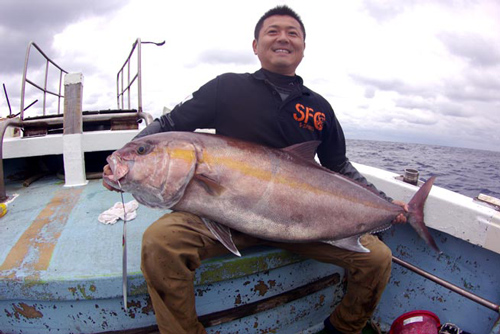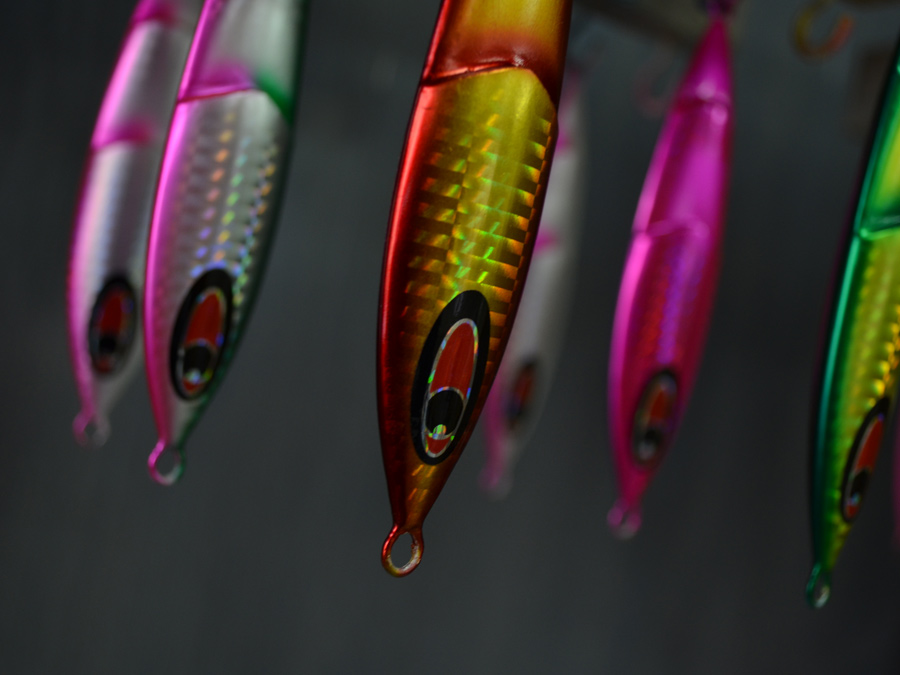High Pitch Jigging
Basic Principles of High Pitch Jerk
High Pitch Jigging (Sato Sensei calls it High Pitch Jerk) is a part of slow pitch jigging. Sato Sensei emphasizes that high pitch jerk is within the variations of slow pitch jigging principle.
The application of slow pitch jigging is to give a moment in every pitch. A moment for the rod to spring back so that the jig swims and falls on its own. You actually let go your jig for the moment. And these moments are when fish makes most bites.
High Pitch Jigging is on the same SPJ principle, but with more power. It utilizes;
- Stronger rod that whips the jig harder.
- Use a reel which has maximum speed, preferably more than 100cm per crank.
- Long jig which has greater momentum to swim on its own.
- Give strong punch (by reeling and jerking) and longer moment to hold up the rod.
As a consequence, the characteristics of high pitch jigging in comparison with slow pitch jigging are;
- The range of jig movements are horizontally wider.
- Works better under the influence of currents and swells.
- Requires far more of your energy.
- Targets bigger fish.
High pitch requires a little different setting from slow pitch.
- Don’t put on the tail hooks as they get tangled with leader.
- May use a big single hook with a thicker assist hook line.
- May use a thicker PE line and leader.
High Pitch Jerk Application
- Swing the rod with the full range from 0 degree down to 90 degrees up. It’s nice to push your rod and reel FORWARD, rather than UPWARD. Your rod will be more angled that way for more spring back to follow. If you try to bring it UPWARD, you’re like to use the muscle in your arms. You’d be totally wasted pretty soon this way. You would want to push FORWARD, using your big muscles in your back, keeping your chin down. You’d want to be as much energy efficient as possible.
- Watch the line slack after pitch. This hang time attracts most bites. It’s nice to bring up the rod to follow the line without giving tension so that you have less line slack and you can sense the contact. And when you just feel the weight of the jig at the tip of your rod, bring it down for another pitch.
- It doesn’t have to be a heavy weight jig. i.e. Slow Pitch Jerker 603-6 with a 100g jig can make high pitch. It just needs to be balanced in strong action tone.
Hope the information helps you! Good luck!
Tags In
Related Posts
12 Comments
Leave a Reply to Totos Cancel reply
Categories
- 1. SPJ (57)
- 1-1. Principles (9)
- 1-2. Techniques (11)
- 1-3. Setup (17)
- 1-4. FAQ (19)
- 1-5. Tackles (3)
- 1-6. Video Gallery (2)
- 2. Other Offshore Games (5)
- 3. Fishing Report (105)
- 3-1. Totos (25)
- 3-2. Readers (72)
- 4. Fish Cooking (19)
- 4-1. Iki-Jime (3)
- 4-2. The Art of Sashimi (5)
- 4-3. Recipe (7)
- 4-4. Seasoning (3)
- 5. Fishing Charter (6)
- Fish (12)







Totoさん、
貴方のビデオはとてもかんしあします~!やぱりたくさんべんきょしますた。
With your explanation & detail, all my confusion and doubts are clear as a clear sky.
I wonder what is the best jig weight range for PHPJ 501, 150gm -300gm? High Gear or Power Gear Reel?
Thank You ありがとうございますた~!
Isaac
Hi Isaac. Thank you for your comment. I’m glad that this information was helpful to you. It really encourages me.
For PHPJ 501, 250g to 350g is ideal, I think.
There’s PHPJ 600. This one works really nice to high pitch lighter jig, 150g to 260g.
Cool video!!!!
So you have your Go pro now?
Looking forward to some slow jerk videos to soon huh?
Great stuff.
Thank you Daz.
I am now working to edit video on slow pitch. It will come out soon!
That is a great demo video. Can this method be used with the shorter, powerful 5′ jigging rods used in high pitch, short jerk jigging?
And forgot ask ask – I presume this technique is only for centre weighed jigs that slide?
Hi Chris.
I still think that High Pitch Jerker is the best for high pitch jigging. But in my opinion, the advantages are much more minor than the advantages that Slow Jerker has over other slow pitch rods. So, I’d say, just give it go and try with your rod. Everything is a variation. And yes, high pitch works well with a center-balanced long jig or semi-long jig which carries more momentum to move straight forward and falls in attractive ways.
Good luck!
Hi u mentioned that the PHPJ 600 works well for 150g to 260g jigs. At what depth?
I’m fishing at over 100m deep up to 200m, 300gm up to 400gm jigs under rough sea condition, targeting amberjack, rubby snapper, groupers, etc. is the PHPJ600 still usable with this high pitch jerk technique ? If not which PHPJ model is more suited?
Also, have u experienced this technique using the beat brunt? Somewhat similar to the PHPJ. Which model do u think best corresponds to the PHPJ600 or which is more suited to the above conditions?
■ bb508-3 [length: 5.8ft (1.73m), metal jig weight average: 100g]
■ bb508-4 [length: 5.8ft (1.73m), metal jig weight average: 130g]
■ bb508-5 [length: 5.8ft (1.73m), metal jig weight average: 180g]
If i can’t get PHPJ, i’ll get the Brunt, BB508-4, keep my options open. thanks for your precious advise Totos.
Hi JCTY.
Did I say that? Maybe it’s for high pitch jigging, huh? Because 600 is great for slow pitch with heavy weight jigs like 400g.
Sea-anchor in 200m… It’s hard for me to imagine it’s possible. It should be more like hi-speed jigging, I guess. If you give suspensions like slow pitch or high pitch, the jig will be moved away from you further and further.
In our vertical situations on a spankered boat which a captain controls the drift, high pitch 410 with 450g long jig is supposed to be the best match in 150m to 200m of water. It can be too hard to do high pitch in deeper water, because the power and the motion range are just not enough to give impacts to the jig in such water resistance.
Sorry, I may not be answering your question, but I recommend to explore more around 100m.
Ho Totos,
Tq for the reply.
I think i misunderstood Your reply above to Isaac on 05-14-2013 “There’s PHPJ 600. This one works really nice to high pitch lighter jig, 150g to 260g.”. thanks for the info.
And your thoughts on the beat brunt? Have you experienced using them? Is the performance comparable to the PHPJ?
Hi JCTY.
No, I have not used Brunt in the field. I know no one who has used it in the field. Sorry I can’t help you there.
Hi Totos,
I am about to start High Pitching and would like some advice on differences between slow and high pitch on terminal tackle. Can you comment on the average values below. I say average as they can differ alot.
Slow High
Hook 2/0 7/0
Assist PE PE20 PE30
Assist Len 4cm 6cm
Split ring #4 #5
Solid ring #4 #5
Main PE 2.0 3.0
Drag 4kg 6kg
As mentioned, these are typical average values, but can differ alot on personal preference. But would like your thoughts on the high pitch values. Thanks.